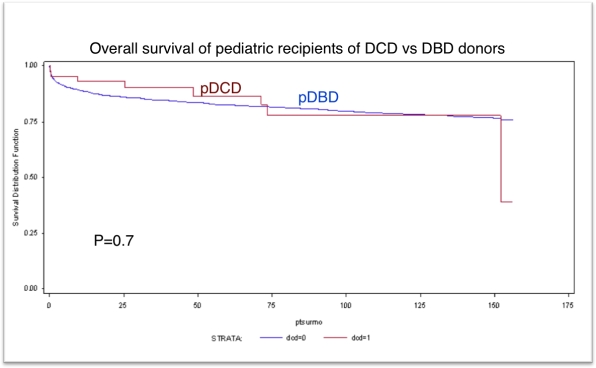Liver Transplantation in Children Using Organ Donation After Circulatory Death– An Analysis of the National Registry
Liver Transplant and Hepatobiliary, Cleveland, Cleveland, OH.
Meeting: 2015 American Transplant Congress
Abstract number: C113
Keywords: Age factors, Allocation, Donors, Liver, non-heart-beating
Session Information
Session Name: Poster Session C: Liver Donation and Allocation
Session Type: Poster Session
Date: Monday, May 4, 2015
Session Time: 5:30pm-6:30pm
 Presentation Time: 5:30pm-6:30pm
Presentation Time: 5:30pm-6:30pm
Location: Exhibit Hall E
The waiting list mortality rate for children is higher than for adults owing to scarce availability of size-appropriate grafts for liver transplantation(OLT). There is a little experience about using organs donation after circulatory death(DCD) in pediatric recipients.
Aim
To compare the long-term national outcomes for children(aged< 18 years)undergoing OLT using DCD versus organs donation after brain death (DBD). The primary outcome measure was graft failure–free survival; the secondary end point was the frequency of retransplantation.
Methods
All children(< 18 years) undergoing primary OLT from DCD and DBD donors were identified from SRTR database. Patient survival was analyzed using the Kaplan–Meier curve and Cox regression.
RESULTS Between 2000-2013, 7874 pediatric recipients received DBD livers vs 47 children received DCD livers(0.6%). DCD pediatric recipients median weight 27.0 kg (5.3–80) and median BMI 21.9(18.7-24.7). The DCD pediatric recipients were significantly older than DBD recipient, however, there were no significant difference in gender, ethnicity, indication for liver transplant, PELD score, retransplantation and immunosuppression between both groups.
| Variables | pDCD (n=47) | pDBD (n=7874) | P value |
|---|---|---|---|
| Age (mean) yrs | 6.4±2.5 | 4.1±1.7 | 0.001 |
| Male (%) | 55% | 51% | 0.67 |
| Ethnicity (%) | 0.35 | ||
| White | 59% | 53% | |
| Black | 18% | 18% | |
| Others | 23% | 29% | |
| Indication of transplantation | 0.72 | ||
| Biliary Atresia | 27% | 34% | |
| Malignant neoplasm | 21% | 6.5% | |
| Acute failure | 12% | 8% | |
| A-1-A | 6% | 2.5% | |
| Others | 34% | 49% | |
| PELD score | 15 | 14 | 0.57 |
| Retransplant | 15% | 8% | 0.19 |
| Immunosuppression | 0.2 | ||
| Tacrolimus | 88% | 91% |
 CONCLUSIONS The national data showed the outcomes of liver transplantation in children using DCD organs were similar to children received DBD organs. The transplant centers appear reluctant to use DCD grafts in the pediatric population, which may ameliorate organ shortage.
CONCLUSIONS The national data showed the outcomes of liver transplantation in children using DCD organs were similar to children received DBD organs. The transplant centers appear reluctant to use DCD grafts in the pediatric population, which may ameliorate organ shortage.
To cite this abstract in AMA style:
El-Gazzaz G, Hashimoto K, Fujiki M, Daigo T, Quintino C, Aucejo F, Kelly D, Winans C, Miller C, Fung J, Eghtesad B. Liver Transplantation in Children Using Organ Donation After Circulatory Death– An Analysis of the National Registry [abstract]. Am J Transplant. 2015; 15 (suppl 3). https://atcmeetingabstracts.com/abstract/liver-transplantation-in-children-using-organ-donation-after-circulatory-death-an-analysis-of-the-national-registry/. Accessed July 5, 2025.« Back to 2015 American Transplant Congress
